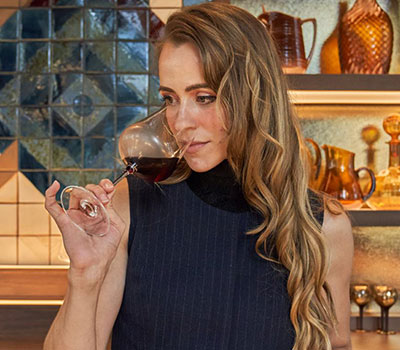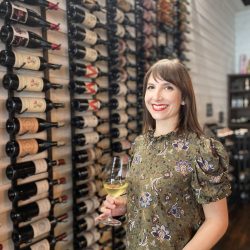Robin Wright moved to New York City in 2013 to study languages, working in hospitality to support her academic pursuits. She quickly became fascinated by wine, and progressed through positions at Aureole, Dovetail, The NoMad and Daniel before being tapped by Danny Meyer to run the beverage program at Ci Siamo, which opened in Manhattan Plaza West in the fall of 2021. Robin has built up the list from 400 wines at opening to more than 1,000 selections today, focusing heavily on Italian wines and supplementing with selections from benchmark regions like California, Burgundy and Champagne. —Stephanie Johnson


What was the concept or brief for Ci Siamo’s wine list?
The idea was to focus on nerdy and indigenous Italian varieties, and I was totally in line with it. About 75 percent of our wines are Italian, and most of those are from indigenous Italian varieties, although I do have a few of those “New World” Super Tuscan wines; I’m not going to alienate people who want that. It’s been fun to seek out little-known varieties like baratuciat [a white Piemontese wine from Iuli, a producer in the Monferrato hills]. The name means “cat balls” because that’s what the grapes look like, and the wine is salty and mineral. Piedmont has so many fun and esoteric varieties, and they all have their own personalities. I’ve listed wines made from slarina, freisa, ruché, grignolino, to name just a few.
How has your staff responded to working with so many esoteric wines?
We’ve been hiring people with all different levels of experience, and it’s been hard to get everyone up to speed on all these indigenous varieties. We do competitions like Wine Jeopardy to get them to memorize the material and put together extensive tech sheets as well as briefer Just the Facts sheets with laterals—so if a customer likes pinot noir, offer them this. It’s been exciting to see them blast through the BTG wines; now I have to reorder every week. The next level will be bringing them up to speed on the stories of the producers. But they’re getting more confident every week.
Your sales reflect a balance of wine styles (45 percent red, 33 white, 20 sparkling and 2 rosé), especially for an Italian restaurant. What accounts for that?
Our servers are great at selling wines BTG. They generally start guests with a white and then go into red. White and rosé almost take over in summer, then back to more red in winter. People need help with our list, because it’s so many indigenous varieties, so they ask what will be best with the food, and they’re willing to try what we recommend. And so many of my reds are light, almost like a rosé or orange.
Which light reds have sold well?
Gulfi’s Cerasuolo [from Sicily] is my moneymaker; it absolutely crushes, because it works for both pinot noir and cabernet drinkers. It’s lighter in tannin but has plenty of body. It goes with a variety of foods, from fish to steak, because it’s so balanced, complex, savory and herbaceous. It’s a huge crowd pleaser.
Do you sell many orange wines, or natural wines, at Ci Siamo?
We’ve had a few orange wines and they’ve all sold out. There are also a lot of winemakers that are making partial-skin contact whites, like Montenidoli’s Vernaccia [one of the Staff Favorites], which macerates for about three to seven days. A lot of our servers are young, and they get enthusiastic about describing the texture of skin-contact wines. I have a lot of natural wine on the list but it’s not super funky or weird, and whatever I have sells. I think it’s because those are the wines that I tend to like. I’ve had people say, “don’t give me any natural wine,” but then I describe it and reassure that it’s not weird, and they usually like it. It’s just a matter of getting them used to traditional wines that happen to be made naturally, even though that’s not a big part of their image.
What are some of your staff’s other favorites?
I’ve had Tiberio’s Trebbiano d’Abruzzo BTG since day one. The price is great, and it’s one of the most food-friendly white wines, perfectly in the middle, not too heavy or too light, so savory and complex. It took a while to get the staff on board selling it, but now they love it. They also love Dislivelli’s Valtellina Rosso [$190/bottle]. It’s such a fun story, from a tiny producer and a new importer [Bryan Garcia]. It hits all the marks of what we want—it’s naturally made, approachable; it can go with almost anything on our menu because the tannins are so fine. It blurs the lines between white and red, and you can almost chug it like a white because it’s so tasty. We’ve noticed some bottle variation, and they totally own that, even showing it on the label. Sometimes I open a bottle and think “that’s good,” then I open another one and think “that’s REALLY good.”
Your wine list is extensive, yet you note that 60 percent of alcohol sales are from the bar. Was that a surprise?
Yes, we didn’t expect that. Our bar manager is Matt Chavez, who also worked with me at The NoMad. He’s well known as a mixologist, and the bar program has taken off much more than we thought it would. You want to have a great martini or spritz, this is the place. Our bar and lounge have started drawing a lot of locals, because you can walk in and get a full dinner there, not just snacks. Lots of date nights. We had an insane January. We were expecting a little slowdown, but that didn’t happen at all.
is the Italian wine editor at Wine & Spirits magazine.
This is a W&S web exclusive. Get access to all of our feature stories by signing up today.


















